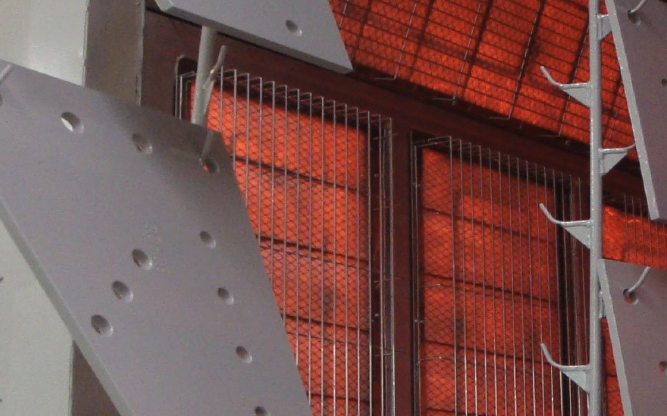In industrial production environments, the efficiency and precision of heat treatment processes are critical to both product quality and energy performance. Among the most innovative solutions available today, Infracat and Boostercat catalytic infrared panels, developed by the Italian company Infragas, stand out for their ability to combine energy efficiency, safety, and versatility. Installing an oven equipped with these systems can significantly improve process control and reduce operating costs, but it also requires careful evaluation of certain technical aspects.
Understanding Infracat and Boostercat technology
The key innovation of Infragas lies in catalytic infrared technology, which allows for heat generation through the oxidation of gas without flame combustion. Unlike conventional systems that rely on convective air heating or open flames, these panels use a catalytic surface that activates a chemical reaction at relatively low temperatures, producing radiant heat in the infrared spectrum.
The Infracat series is designed for applications that require uniform and consistent heating—for example, drying paints, curing coatings, or preheating materials such as metals, plastics, or composites.
The Boostercat line, on the other hand, reaches higher surface temperatures (up to around 650 °C) and is used where rapid heating and higher energy density are required, such as in intensive curing or sintering processes.
The main advantages for industrial applications
Installing an oven with Infracat or Boostercat panels offers several tangible benefits that go beyond mere energy savings.
1. Energy efficiency and reduced consumption
Catalytic infrared systems transfer heat directly to the material’s surface, avoiding the energy dispersion typical of air-based systems. This leads to faster processing times and up to 30–40% savings in fuel consumption compared to traditional convective ovens.
2. Greater control and product quality
Infrared radiation heats materials from the inside out, allowing for precise control over temperature distribution. The result is a more uniform finish, crucial in sectors like automotive, wood coating, packaging, or electronics, where even small imperfections can affect the final product.
3. Faster start-up times
Both Infracat and Boostercat panels reach operating temperature in less than 10 minutes, enabling a rapid start of production lines and minimizing downtime. This feature is particularly appreciated in batch processes or facilities where operational flexibility is required.
4. Compact design and flexibility
Ovens built with catalytic panels require less space because they don’t rely on large air circulation systems. They can be installed horizontally, vertically, or at an angle, adapting to existing layouts and even retrofitting older production lines.
5. Safe operation and compliance
Infragas systems are flameless, which drastically reduces explosion and fire risks. Their design meets ATEX and FM certifications, making them suitable for use in potentially explosive or solvent-rich environments, such as painting booths or chemical treatment plants.
Critical points and aspects to evaluate before installation
While the advantages are clear, implementing catalytic infrared systems also involves a few challenges that must be carefully considered during project planning.
Gas supply and control system
Infracat and Boostercat panels operate on natural gas, propane, or butane. It is crucial to ensure a stable and clean gas supply, as fluctuations in pressure or contamination can affect catalytic performance. Installing precise gas control systems and filters is essential to maintain reliability and efficiency.
Proper ventilation and exhaust design
Although the combustion process is flameless and low in emissions, airflow and ventilation must be correctly calculated to avoid heat accumulation or unbalanced gas distribution. Consulting experienced engineers ensures compliance with safety standards and optimal performance.
Maintenance and catalyst lifespan
The catalytic layer of the panels has a long service life, typically exceeding 10,000 operating hours, but it must be periodically inspected and cleaned to prevent dust or residue buildup. Regular maintenance helps preserve uniform heat emission and extends the lifespan of the system.
Initial investment and ROI
Compared to traditional hot-air ovens, the initial cost of catalytic infrared systems may be higher due to advanced materials and controls. However, the investment often pays off within one to three years, thanks to lower energy bills, reduced maintenance, and higher production throughput.
Key industrial applications
Infragas panels are currently used in a wide range of industries that require precise and controlled thermal processing, including:
- Automotive and transport – drying and curing paints or coatings.
- Wood and furniture – treatment of MDF or HDF surfaces, varnish drying.
- Textiles and composites – preheating and thermoforming of synthetic fabrics.
- Food and packaging – sterilization and controlled dehydration processes.
- Metal treatment – powder coating curing and preheating before forming.
In each application, Infracat and Boostercat technologies help reduce cycle times while maintaining consistent temperature control and environmental compliance.
Moving toward the future of industrial heating
Installing an oven equipped with Infracat or Boostercat catalytic panels means adopting a forward-thinking solution that meets the demands of modern manufacturing: energy efficiency, precision, and safety. These systems represent a step toward sustainable production, reducing emissions and operating costs without compromising performance.
For companies looking to modernize their production lines or replace obsolete heating systems, partnering with Infragas offers a tangible competitive advantage. The company’s continuous research, certified manufacturing, and technical support make it a reliable reference in the field of infrared catalytic heating systems—an area destined to play an increasingly central role in industrial innovation.

